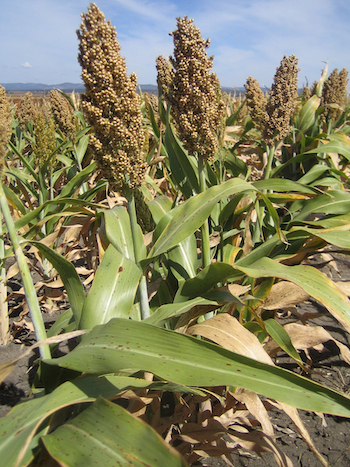Studies of highly drought-adapted sorghum plants have culminated in gene discoveries that enable breeders to better-protect cereal crops from the devastating food security impacts of water scarcity.
The discovery is the culmination of 30 years of research by a tag team of researchers and breeders at the Queensland Alliance for Agriculture and Food Innovation (QAAFI) and Department of Agriculture and Fisheries (DAF), which relied heavily on GRDC investment. Most recently the work was led by Professor Andrew Borrell.
Starting in the 1980s, plant breeders in the US (the late Dr Darrell Rosenow) and Australia (the late Dr Bob Henzell) noticed that some sorghum lines maintained green leaves for longer under dry conditions, leading to higher grain yield and lodging resistance under end-of-season drought. The trait was called ‘stay-green’.
 Stay-green sorghum uses water resources more efficiently in drought periods. The plants remain healthier which give them increased resistance to pathogens and lodging. Photo: Andrew Borrell
Stay-green sorghum uses water resources more efficiently in drought periods. The plants remain healthier which give them increased resistance to pathogens and lodging. Photo: Andrew Borrell
Sustained efforts by the Australian public sector sorghum pre-breeding program, led by QAAFI’s Professor David Jordan, kept stay-green front-and-centre as a selection target. However, while the trait proved exceptionally useful – and is now the backbone of the Australian sorghum industry – nobody initially knew how it worked. That’s the challenge which legendary breeder Dr Bob Henzell charged Professor Borrell to solve.
“When I first arrived in south-eastern Queensland in the early 1990s, Bob told me that stay-green increased sorghum yield under drought, but he added that he didn’t know why,” Professor Borrell says. “He then issued me the challenge, as a physiologist, to find out why. That was almost 30 years ago!”
Now, Professor Borrell has made a vitally important breakthrough in this decades-long quest.
“With stay-green, we see very specific physiological and morphological changes both in the way the plants grow above the ground and below in the roots,” Professor Borrell says. “At QAAFI, we have systematically characterised the trait, starting with overall plant biology and, most recently, digging down to the gene level. We have now uncovered genetic clues that allow a major step-change in our ability to breed for drought tolerance.”
The breakthrough centres around the nine members of the PIN gene family in sorghum, some of which genetically align with chromosome regions previously implicated in mediating stay-green characteristics. These PIN genes act in concert to regulate the distribution and localised concentration of the plant hormone auxin in different tissues of the plant, which, in turn, trigger various biological mechanisms, including characteristics that aid in drought adaptation.
Different patterns of PIN gene expression in stay-green varieties bring about specific auxin distributions that cascade into physiological changes that keep leaves greener for longer, through three main mechanisms:
- they reduce the plant’s need for water before flowering by producing a smaller canopy;
- they increase the plant’s supply of water by producing deeper roots; and
- they increase the efficiency in the way the plant uses water.
Importantly, the QAAFI team dissected the role of individual sorghum PIN genes and identified three, in particular, that create unprecedented opportunities to design the drought adaptation characteristics of commercially grown sorghum.
Dissecting PIN gene function involved an epic round of resource development that created plants that either over-express the specific PIN genes (via genetic transformation) or knock out these genes (via CRISPR-Cas9 gene editing technology). These genetic resources were primarily developed by QAAFI’s Dr Karen Massel and characterised by PhD student Albert Wong as part of Professor Borrell’s ARC Discovery project.
“We discovered that various combinations of PIN genes can be used to change the root, canopy, leaf anatomy, photosynthesis and panicle characteristics of sorghum crops in ways that affect drought resilience,” Professor Borrell says. “That means we now have a toolkit to custom-make crops suited to dry environments and to a changing climate.”
For example, the distribution of roots in the soil through space and time (known as root architecture), is the result of three cellular processes: curving, elongating and branching. The QAAFI team found that, to some extent, PIN genes regulate all three processes. “Various combinations of PIN genes can be used to design specific root systems in order to increase water supply to crops or to potentially store significantly more carbon below-ground,” Professor Borrell says.
PIN genes also regulate above-ground branching and leaf size, which determines how much water the crop uses.
There are also opportunities to improve the plant’s water use efficiency via changes to leaf anatomy, including processes that affect photosynthesis.
“Some of the PIN genes even affect panicle architecture and, therefore, yield potential – so the opportunities for crop design are significant,” Professor Borrell says.
Importantly, genetic similarities with other cereal crops – including wheat and barley – means that these genetic findings are targets to aid in the development of drought resilience in other Australian cereal crops. Work to understand the impact of PIN genes in other cereals is already under way, led by Professor Borrell.
This work has hugely important implications. Drought is considered the single greatest cause of food production losses globally by the United Nations’ Food and Agriculture Organisation (FAO). In low-and-middle-income countries, those losses are estimated at 34 per cent of crop and livestock production, amounting to a total cost of US$37 billion – sums these countries can ill-afford.
More information: Andrew Borrell, a.borrell@uq.edu.au

























































